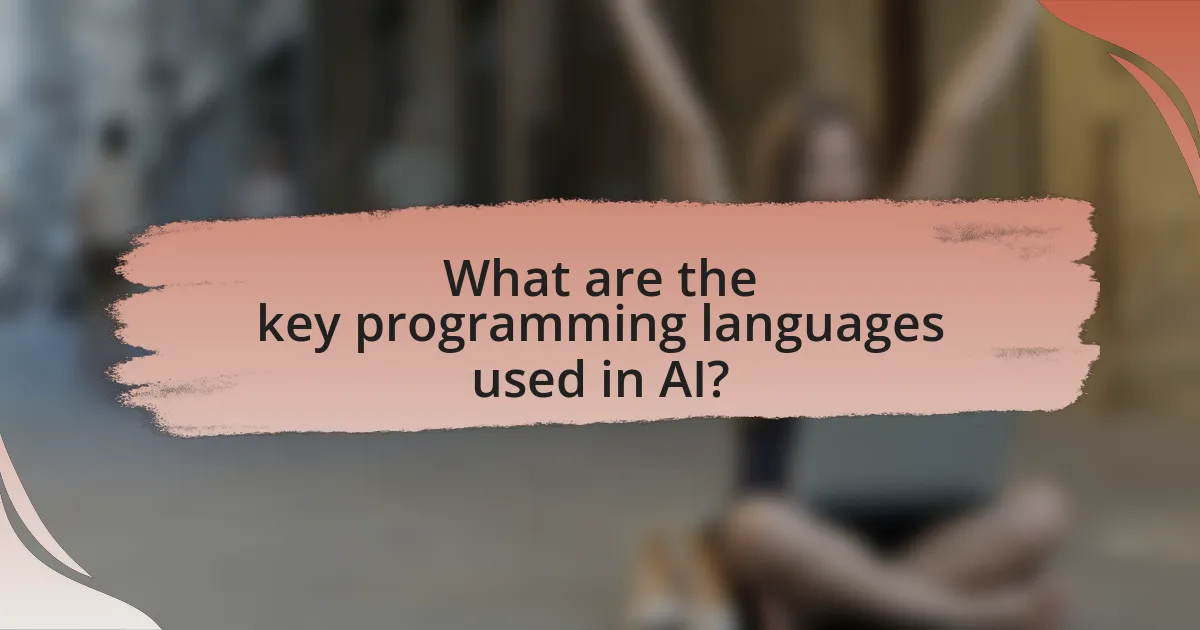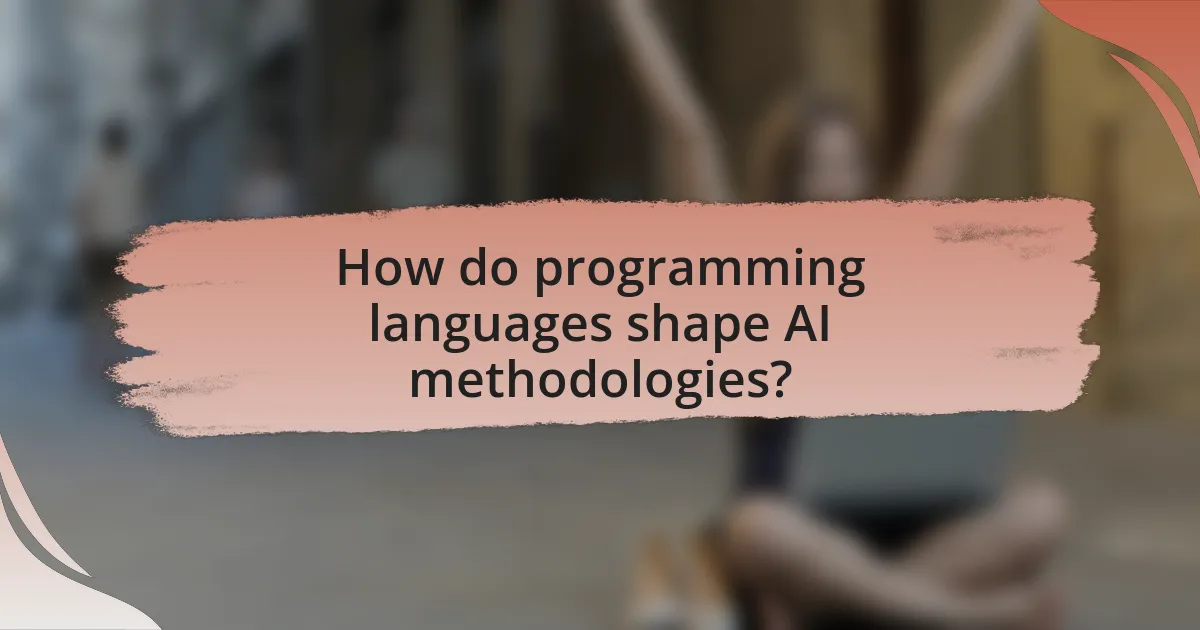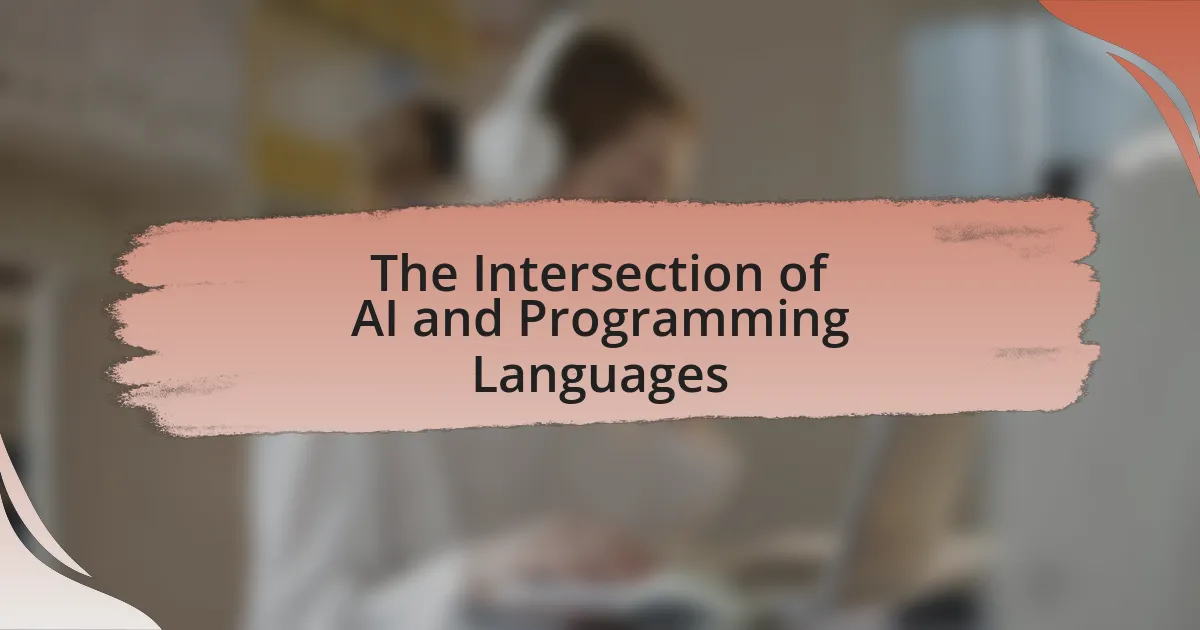The intersection of AI and programming languages is crucial for developing algorithms that enable machines to perform tasks requiring human intelligence. Key programming languages such as Python, R, and Java play significant roles in AI development, offering extensive libraries and frameworks that enhance model building and data manipulation. This article explores how AI influences programming languages, the implications for software development, and the evolving job market in tech. It also examines the strengths of various languages in AI applications, emerging languages gaining traction, and best practices for developers to optimize their AI projects. Understanding this intersection is essential for creating efficient AI systems and adapting to the rapidly changing technological landscape.

What is the Intersection of AI and Programming Languages?
The intersection of AI and programming languages lies in the development and implementation of algorithms that enable machines to perform tasks typically requiring human intelligence. Programming languages such as Python, R, and Java are extensively used in AI for building models, data manipulation, and executing machine learning algorithms. For instance, Python’s libraries like TensorFlow and PyTorch facilitate deep learning, while R is favored for statistical analysis in AI research. The choice of programming language can significantly influence the efficiency and effectiveness of AI applications, as evidenced by the widespread adoption of Python in the AI community due to its simplicity and robust ecosystem.
How do AI and programming languages interact?
AI and programming languages interact through the development and execution of algorithms that enable machines to learn from data. Programming languages provide the syntax and structure necessary for implementing AI models, such as Python, which is widely used due to its extensive libraries like TensorFlow and PyTorch that facilitate machine learning. Furthermore, programming languages allow for the integration of AI capabilities into applications, enabling functionalities such as natural language processing and computer vision. The interaction is evidenced by the increasing use of domain-specific languages designed for AI tasks, which optimize performance and usability in AI development.
What role do programming languages play in AI development?
Programming languages are essential in AI development as they provide the tools and frameworks necessary for building algorithms and models. They enable developers to implement complex mathematical computations, manage data structures, and create efficient code for processing large datasets. For instance, Python, a widely used programming language in AI, offers libraries like TensorFlow and PyTorch that facilitate deep learning and neural network construction. The choice of programming language can significantly impact the performance and scalability of AI applications, as evidenced by studies showing that Python’s simplicity and extensive libraries have accelerated AI research and deployment, making it the dominant language in the field.
How does AI influence the evolution of programming languages?
AI significantly influences the evolution of programming languages by driving the development of new paradigms and enhancing existing ones. For instance, AI techniques such as machine learning and natural language processing have led to the creation of languages that prioritize ease of use and efficiency, like Python, which has become popular for AI applications due to its simplicity and extensive libraries. Furthermore, AI tools are increasingly integrated into development environments, enabling features like code completion and error detection, which streamline the coding process and improve productivity. This trend is evidenced by the rise of AI-assisted programming tools, such as GitHub Copilot, which utilizes AI to suggest code snippets, thereby shaping how programming languages are utilized and evolved in practice.
Why is understanding this intersection important?
Understanding the intersection of AI and programming languages is crucial because it enables developers to create more efficient and effective AI systems. This intersection allows for the optimization of algorithms and the development of new programming paradigms that can better handle the complexities of AI tasks. For instance, languages like Python, which have extensive libraries for machine learning, facilitate rapid prototyping and deployment of AI models, demonstrating the practical benefits of this understanding. Furthermore, as AI continues to evolve, programming languages must adapt to support new methodologies, making this knowledge essential for staying relevant in the tech industry.
What are the implications for software development?
The implications for software development at the intersection of AI and programming languages include increased efficiency, enhanced code quality, and the potential for automation in coding tasks. AI-driven tools can analyze code patterns, identify bugs, and suggest optimizations, leading to faster development cycles. For instance, a study by Microsoft Research found that AI-assisted coding can reduce the time developers spend on routine tasks by up to 30%. Additionally, the integration of AI can facilitate the creation of more adaptive programming languages that can learn from user behavior, further streamlining the development process.
How does this intersection affect job markets in tech?
The intersection of AI and programming languages significantly enhances job markets in tech by increasing demand for skilled professionals who can develop and implement AI solutions. As organizations adopt AI technologies, they require programmers proficient in languages that support AI frameworks, such as Python, R, and Java. According to the World Economic Forum, by 2025, 85 million jobs may be displaced by a shift in labor between humans and machines, but 97 million new roles could emerge that are more adapted to the new division of labor. This shift indicates a growing need for tech workers who can bridge the gap between AI capabilities and programming expertise, ultimately leading to a more dynamic and evolving job market in the tech sector.

What are the key programming languages used in AI?
The key programming languages used in AI are Python, R, Java, C++, and Julia. Python is the most popular due to its simplicity and extensive libraries like TensorFlow and PyTorch, which facilitate machine learning and deep learning. R is favored for statistical analysis and data visualization, making it useful in data-driven AI projects. Java is known for its portability and scalability, often used in large-scale systems. C++ offers performance advantages, particularly in resource-intensive applications, while Julia is gaining traction for its speed and ease of use in numerical and scientific computing. These languages collectively support a wide range of AI applications, from machine learning to natural language processing.
Which languages are most popular for AI applications?
Python is the most popular language for AI applications, widely recognized for its simplicity and extensive libraries such as TensorFlow, PyTorch, and scikit-learn. According to the 2023 Stack Overflow Developer Survey, Python is the most commonly used language among developers working on AI and machine learning projects, with over 50% of respondents indicating its use. Additionally, R is favored for statistical analysis and data visualization in AI, while Java and C++ are also utilized for their performance in large-scale applications. These languages collectively support a diverse range of AI functionalities, making them essential in the field.
What are the strengths of Python in AI?
Python’s strengths in AI include its simplicity, extensive libraries, and strong community support. The language’s straightforward syntax allows developers to write and understand code quickly, which accelerates the development process. Additionally, Python boasts a rich ecosystem of libraries such as TensorFlow, PyTorch, and Scikit-learn, which provide pre-built functions and tools for machine learning and data analysis, making it easier to implement complex algorithms. Furthermore, the active community contributes to continuous improvements and a wealth of resources, including tutorials and documentation, which facilitate learning and troubleshooting. These factors collectively position Python as a leading choice for AI development.
How does R compare to other languages in AI tasks?
R is less commonly used for AI tasks compared to languages like Python and Java, primarily due to its focus on statistical analysis rather than general-purpose programming. While R excels in data visualization and statistical modeling, Python offers extensive libraries such as TensorFlow and PyTorch that are specifically designed for machine learning and deep learning applications. Additionally, Java provides robust frameworks like Weka and Deeplearning4j, which are also tailored for AI development. According to the TIOBE Index, Python consistently ranks as one of the top programming languages for AI, reflecting its widespread adoption in the field.
What emerging languages are gaining traction in AI?
Emerging languages gaining traction in AI include Julia, Rust, and Swift. Julia is recognized for its high performance in numerical and scientific computing, making it suitable for AI applications. Rust offers memory safety and concurrency, which are beneficial for building robust AI systems. Swift, originally designed for iOS development, is increasingly being adopted for machine learning tasks due to its ease of use and performance capabilities. These languages are being integrated into AI frameworks and libraries, reflecting their growing importance in the field.
How is Julia positioned in the AI landscape?
Julia is positioned as a high-performance programming language that is particularly well-suited for numerical and scientific computing in the AI landscape. Its design allows for easy integration with other languages like Python and C, facilitating the development of AI applications that require speed and efficiency. Julia’s ability to handle large datasets and perform complex mathematical computations quickly makes it a preferred choice among researchers and data scientists, as evidenced by its growing adoption in machine learning frameworks and libraries such as Flux.jl and MLJ.jl.
What advantages does Go offer for AI development?
Go offers several advantages for AI development, including simplicity, concurrency, and performance. The language’s straightforward syntax allows developers to write clear and maintainable code, which is essential for complex AI systems. Go’s built-in support for concurrency through goroutines enables efficient handling of multiple tasks simultaneously, making it suitable for processing large datasets or running parallel computations often required in AI applications. Additionally, Go’s performance is comparable to lower-level languages like C, allowing for faster execution of algorithms, which is critical in AI where speed can significantly impact results. These features collectively enhance the development process and efficiency of AI projects.

How do programming languages shape AI methodologies?
Programming languages significantly shape AI methodologies by providing the tools and frameworks necessary for implementing algorithms and models. For instance, Python, with its extensive libraries like TensorFlow and PyTorch, facilitates rapid development and experimentation in machine learning, making it the preferred choice for many AI researchers. Additionally, languages such as R are tailored for statistical analysis, influencing methodologies in data-driven AI applications. The choice of programming language impacts the efficiency, scalability, and ease of use of AI systems, as evidenced by the dominance of Python in AI research, which accounted for over 57% of AI-related projects in 2021 according to a survey by Stack Overflow. Thus, the characteristics and capabilities of programming languages directly inform the methodologies employed in AI development.
What programming paradigms are prevalent in AI?
The prevalent programming paradigms in AI are functional programming, object-oriented programming, and logic programming. Functional programming, exemplified by languages like Haskell and Scala, emphasizes immutability and first-class functions, which are beneficial for handling complex data transformations in AI. Object-oriented programming, used in languages such as Python and Java, facilitates the modeling of real-world entities and promotes code reusability, making it suitable for building AI systems. Logic programming, primarily represented by Prolog, focuses on formal logic and is effective for tasks involving knowledge representation and reasoning. These paradigms support the development of AI applications by providing frameworks that enhance code organization, maintainability, and scalability.
How does functional programming benefit AI algorithms?
Functional programming benefits AI algorithms by promoting immutability and higher-order functions, which enhance code reliability and modularity. Immutability ensures that data cannot be altered after creation, reducing side effects and making it easier to reason about program behavior, which is crucial in AI applications that require consistent and predictable outcomes. Higher-order functions allow for the creation of more abstract and reusable code, facilitating the implementation of complex algorithms such as those used in machine learning. Research has shown that languages like Haskell, which emphasize functional programming, can lead to more concise and maintainable code, ultimately improving the efficiency of AI development processes.
What is the significance of object-oriented programming in AI?
Object-oriented programming (OOP) is significant in AI because it facilitates the modeling of complex systems through encapsulation, inheritance, and polymorphism. These principles allow developers to create modular and reusable code, which is essential for managing the complexity of AI algorithms and data structures. For instance, OOP enables the representation of real-world entities as objects, making it easier to simulate and manipulate them in AI applications. Additionally, languages like Python, which support OOP, are widely used in AI development due to their simplicity and extensive libraries, such as TensorFlow and PyTorch, that leverage OOP concepts to streamline machine learning processes.
How do language features impact AI performance?
Language features significantly impact AI performance by influencing the efficiency and effectiveness of algorithms used in natural language processing. For instance, languages with rich syntactic structures enable more nuanced understanding and generation of text, which enhances AI’s ability to interpret context and semantics. Research shows that programming languages designed for AI, such as Python, provide extensive libraries and frameworks that streamline the development of machine learning models, thereby improving performance metrics like accuracy and processing speed. Additionally, languages that support functional programming paradigms can lead to more concise and maintainable code, which facilitates rapid experimentation and iteration in AI projects.
What role do libraries and frameworks play in AI programming?
Libraries and frameworks are essential in AI programming as they provide pre-built functions and tools that streamline the development process. These resources enable developers to implement complex algorithms and models without needing to code everything from scratch, significantly reducing development time and effort. For instance, TensorFlow and PyTorch are widely used frameworks that facilitate deep learning tasks, offering optimized performance and extensive community support. Their comprehensive documentation and user-friendly interfaces allow programmers to focus on model design and experimentation rather than low-level implementation details. This efficiency is crucial in AI, where rapid prototyping and iteration are often necessary to achieve effective results.
How does language efficiency affect AI model training?
Language efficiency significantly impacts AI model training by influencing the speed and resource consumption of the training process. Efficient programming languages enable faster execution of algorithms, which reduces the time required for training models. For instance, languages like Python, with optimized libraries such as TensorFlow and PyTorch, allow for rapid prototyping and execution of complex neural networks, thereby enhancing training efficiency. Additionally, efficient language constructs can minimize memory usage and computational overhead, leading to lower costs and improved scalability in training large datasets. This correlation between language efficiency and training performance is supported by studies showing that optimized code can lead to performance improvements of up to 50% in training times for deep learning models.
What best practices should developers follow when using programming languages for AI?
Developers should follow best practices such as selecting the appropriate programming language based on project requirements, ensuring code modularity for easier debugging and maintenance, and utilizing libraries and frameworks optimized for AI tasks. For instance, Python is widely favored for AI due to its extensive libraries like TensorFlow and PyTorch, which facilitate machine learning and deep learning implementations. Additionally, developers should prioritize data preprocessing and cleaning, as high-quality data significantly impacts model performance. According to a study by Google Research, effective data handling can improve model accuracy by up to 30%. Furthermore, implementing version control systems, such as Git, is essential for tracking changes and collaborating effectively in AI projects. These practices collectively enhance the efficiency and reliability of AI development.
How can developers choose the right language for their AI project?
Developers can choose the right language for their AI project by evaluating the specific requirements of the project, such as performance, ease of use, and available libraries. For instance, Python is widely favored for its extensive libraries like TensorFlow and PyTorch, which facilitate machine learning and deep learning tasks. Additionally, languages like R are preferred for statistical analysis, while C++ may be chosen for performance-critical applications. The choice should also consider community support and documentation, as these factors significantly impact development efficiency and troubleshooting.
What common pitfalls should be avoided in AI programming?
Common pitfalls to avoid in AI programming include overfitting, lack of data diversity, and ignoring ethical considerations. Overfitting occurs when a model learns noise in the training data rather than the underlying pattern, leading to poor performance on unseen data. A study by Hastie, Tibshirani, and Friedman in “The Elements of Statistical Learning” highlights that models with excessive complexity are prone to overfitting. Lack of data diversity can result in biased models that do not generalize well across different populations, as demonstrated in research by Buolamwini and Gebru in “Gender Shades,” which showed that facial recognition systems performed poorly on darker-skinned individuals. Ignoring ethical considerations can lead to harmful consequences, such as reinforcing stereotypes or violating privacy, as discussed in the “AI Now Report 2018” by the AI Now Institute. Addressing these pitfalls is crucial for developing robust and responsible AI systems.

Leave a Reply